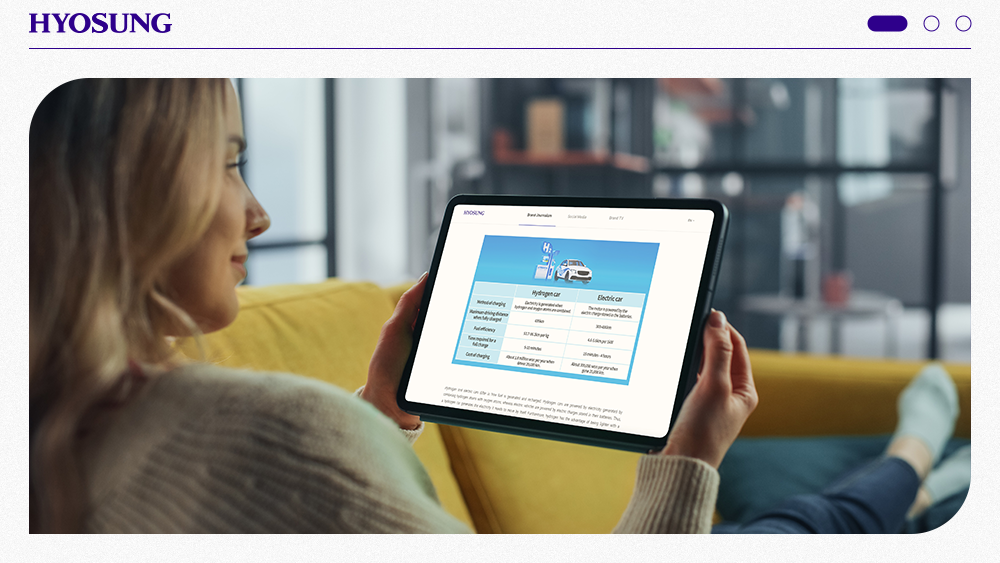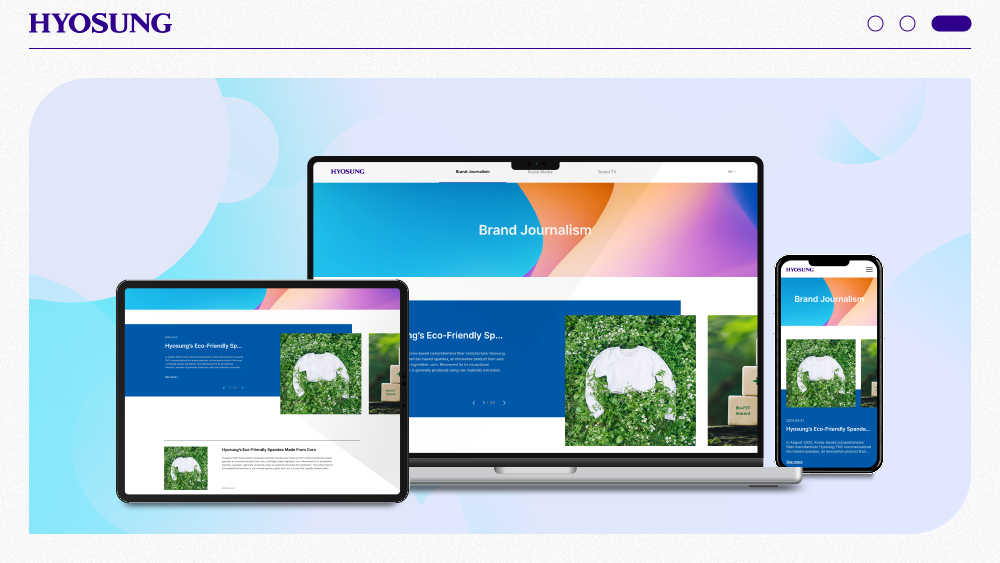Brand Media of Hyosung
2023.06.16
In the evolving modern society, marketing is an accurate reflection of the social flow and trends of the times. A major marketing phenomenon rivaling search engines and social media in importance today is brand journalism. Hyosung has adopted expert brand journalism methodologies for brand communication with customers. Hyosung's exclusive brand journalism is referred to as the "brand media of Hyosung." The company develops exclusive brand media through brand journalism.
The brand media of Hyosung provide subscribers with stories about its subsidiaries and Hyosung Group that are in-depth yet easy to understand. The brand media are in both Korean and English, for international customers visiting Hyosung's brand journalism webpage.
Hyosung joins many other companies focusing on brand journalism. What are the origins of brand journalism and what are its effects?
Brand Media, Brand Journalism?
Brand media of Hyosung are based on brand journalism, a method of marketing that combines advertising and journalism. It is characterized as producing news articles and other content that consumers find useful, while also employing the principles on which journalists work in content marketing. Brand journalism allows a company to put out brand narratives without direct marketing or sales activities and provides consumers with accurate and detailed information about a company as such. From the consumer's standpoint, brand journalism content must be worth reading, deliver a point, and be interesting.
With the advances made on the internet and technology, people are exposed to more and more advertising and information. One effect of that is that they do not rely 100% on advertising and news, but rather turn to brand narratives to form conclusions about companies. Because brand narratives are written to have a company or organization come across as a persona through media, a bond between the customer and company is created. A brand story is usually written by an employee of a company with expert knowledge of its business, so the reader can have confidence in it.
A customer can access accurate information about the products and services a company provides by reading brand journalism materials written by an expert on the company, and can even come across additional, unexpected knowledge about it.
In an age where the traditional marketing method such as advertising alone cannot fully engage and intrigue customers, companies can use brand journalism to convince target audiences to trust and relate to their brands, which raises the value of a company and its brand in the customer's eye.

History of Brand Journalism
Brand journalism dates back about 20 years. It was when the public's trust in the business sector was at its lowest in the aftermath of the global financial crisis. Larry Light, then-chief marketing officer of McDonald's, said in 2004 that mass marketing was no longer effective, that a single advertisement could not tell the whole story about a company, and that McDonald's would resort to brand journalism, a new marketing technique.
Under Larry Light's direction, McDonald's departed from the traditional marketing and advertising focused on brand positioning and issued news article-style content through a variety of channels. Its brand journalism was akin to a chief editor's creation of a magazine covering a diverse range of topics.
Boeing, Cisco, and many other companies have followed in McDonald's footsteps and reaped the benefits of brand journalism. Perhaps the most well-known case is the brand journalism of the Coca-Cola Company. In 2012, the Coca-Cola Company launched its digital magazine, Coca-Cola Journey. Published daily, Coca-Cola Journey is a potpourri of narratives about the world of Coca-Cola, including descriptions of Coca-Cola products and advertising campaigns, narratives of interest to Coca-Cola buffs, interviews with Coca-Cola Company employees, information about the company's brand and history, and job ads. Coca-Cola Journey was such a success that the Coca-Cola Company integrated its official website into Coca-Cola Journey.
Difference between Brand Journalism & News Articles
How brand journalism differs fundamentally from traditional media is that its target is the consumer, not media outlets. Let's compare brand journalism with two common types of media formats: press releases and special articles.
A press release is an article prepared by a company about its brand and offerings, and distributed to broadcasters, newspapers, magazines, and other media outlets. The article gets edited by a media outlet and reaches its target audience under the byline of a staff member at the media outlet, so more often than not it can reflect added opinions or biases of the media outlet. Because media outlets are inundated with press release requests from companies, if a particular company's press release does not get picked, its narrative will not reach the end consumers.
Alternatively, brand journalism can deliver a company's independently produced content and narratives to the consumers through its own channel. A brand journalism narrative does not get distorted by third parties.

A special article is a news article about a company or brand written in a way to pique the reader’s interest by the consumer. Compared to a regular news article, a special article is longer and more in-depth, but its narrative is not disseminated, because it is released by a single media outlet.
A special article about a company or brand usually mentions other companies and brands as well, resulting in a loss of reader’s focus on the main company or brand, whereas brand journalism focuses entirely on one company or brand so that the reader is thinking only about that one company or brand.
Today, when the public's distrust of the media is high, brand journalism presents the most effective communication channel for a company.
Hyosung’s Way to Deliver Its Brand Media
For Hyosung, which does business in many countries, its brand journalism, or brand media, is about making potential customers worldwide aware of its global leadership and all the different activities that its subsidiaries and their brands conduct in their respective business areas.
Hyosung is particularly prolific in the B2B business. Since the general public would not be familiar with its eco-friendly materials development, customer-friendly management, data-centric operations, and ESG management, narratives that paint a genuine picture of Hyosung are released to inform target audiences that Hyosung is a company and a global premium brand that leads positive change.
Hyosung's narratives are strategically categorized. The worsening climate change has made ESG management a requisite for companies. Since long ago, Hyosung has foreseen the changing times and searched for the right path for mankind to take. That is how it has developed its innovative technologies and products, which are eco-friendly and sustainable for future generations and distinctly Hyosung. Its brand media allows its technologies and products, commonly used in everyday life, to be introduced to the audience. Moreover, it introduces the values we pursue for the sake of our future generations, and how Hyosung's mission and vision are aligned with this pursuit. Those values are explained in narratives about Hyosung's breakthrough technologies that make sustainability and innovation possible. Hyosung subsidiaries operate in lockstep with the mission and vision of Hyosung Group and are responsible for upholding the core values of Hyosung in their respective fields of business.
The brand media of Hyosung provides readers with an understanding of its heritage and subsidiaries, core technologies and products, what it is doing for the environment, and the corporate identity that underlies its operations.

Brand Media of Hyosung in the Everyday Life
The brand media of Hyosung delivers easy-to-follow narratives about not only brands the average consumer would be familiar with, like regen®, but also Hyosung-led businesses that would likely be unfamiliar to the general public such as hydrogen, tirecords, carbon fiber, films, and pumps to give them a good understanding of the many different Hyosung-led businesses. Delving into Hyosung's industries and businesses, these narratives are informative to industry professionals as well.
Hyosung cares deeply about climate change, and stories about its ESG activities allow consumers to learn about its unsung efforts and rediscover its true value.
The brand media of Hyosung is posted on the official website as well as Instagram, LinkedIn, Facebook, etc., edited for a lighter vibe. The imagery featured in Hyosung's brand media delivers sophisticated visual messages that encapsulate Hyosung.
Its brand media is more than just an outlet for information. It is a window that looks into its various B2B businesses which the average consumer would not interact with directly. The audience gets to understand the true value of Hyosung, its technologically driven and environmentally conscious management. You can connect with how Hyosung works to improve the quality of life for man step by step.
You are invited to open the brand media of Hyosung to understand its past, present, and future as a company working to create new value for you.